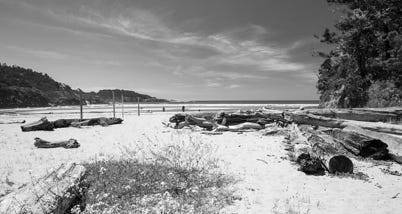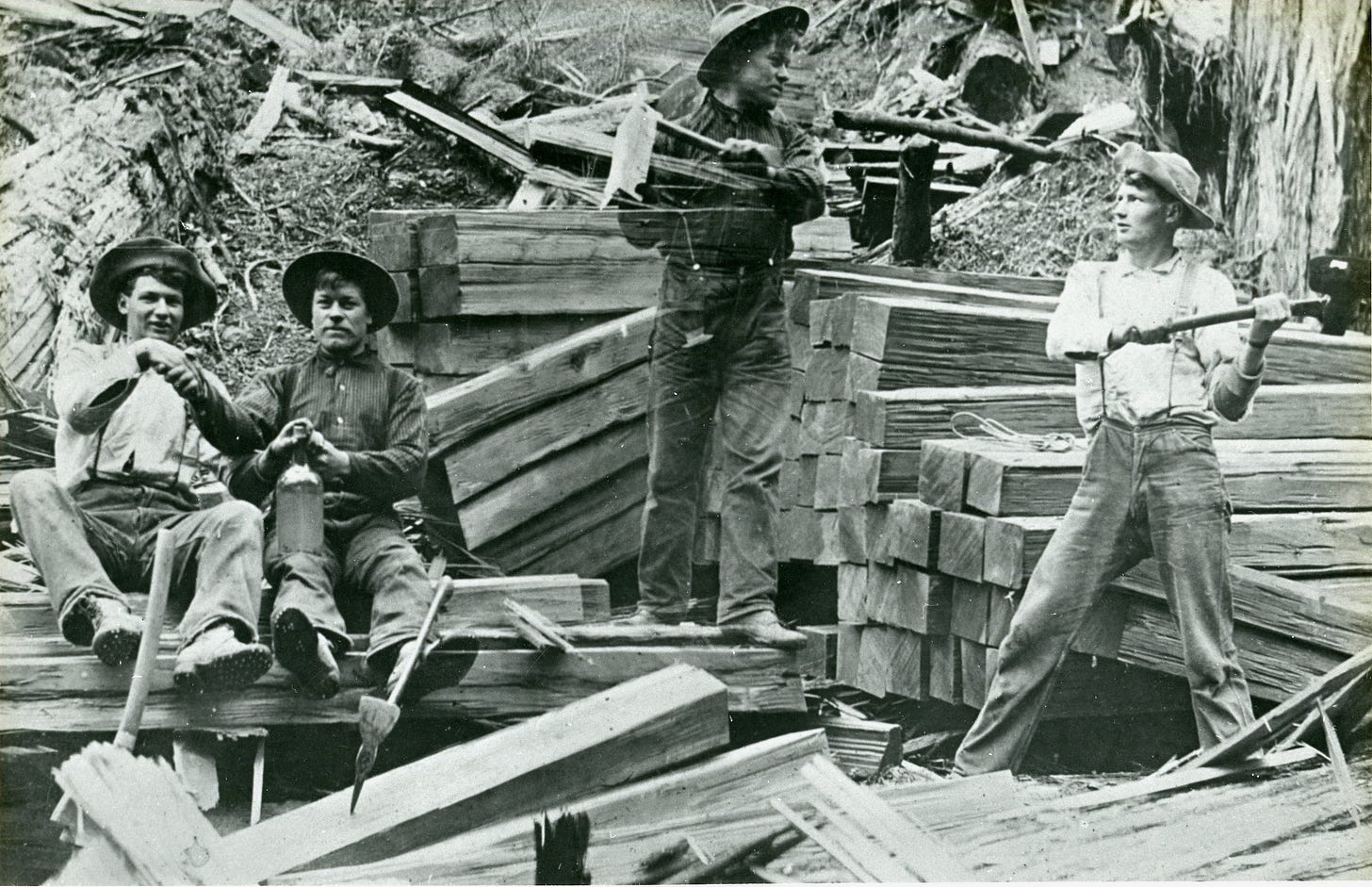Children, your fathers roamed these hills and valleys in freedom. There was plenty of deer in the forests and fish in the streams. There was plenty for all. There were no white men from the land of the sunrise to draw lines upon the ground and say that the land was theirs… Who has driven the game away? The white man. Who has taken our lands and made slaves of us? The white man… The white man says we must not steal, that we must not steal a blanket, that we must not steal a coat. You must not steal at all, but he has stolen everything from us.
Pomo Chief Dock, 1989. In Fort Bragg Remembered, A Centennial Oral History.
Pomo, as many tribal names, means “people”. The Buldam Pomo are a group who camped in Comptche on their annual migrations between their winter camp in Ukiah and Buldam, their summer camp at the mouth of Big River.
The name “Comptche” has no definitive source or translation, but local wisdom holds that the place was named by early settlers for the Pomo’s Chief Comptche. Elsa Thompson wrote in 1973 that “Comptche” is a Pomo word meaning “in the valley of many hills,” but there is no other data to support this translation.
UC Berkeley anthropologists researched and worked with remaining Pomo people in the early 1900s. They found that the Pomo are not a single tribe but are made up of independent tribes with seven distinct languages, and that the pre-contact population of Pomo was around 8,000.
The Mendocino Indian Reservation was established in 1855 on the coast north of Mendocino County. An Indian Agent and military were posted at Fort Bragg, and the town of Fort Bragg was then established in 1857. The Mendocino Reservation closed in 1866 and the native people were moved and consolidated on the Round Valley Indian Reservation, north of Ukiah.
The village of Mendocino was founded in the early 1850s as a logging community. The saw mill was situated on the north bank of Big River, previously the site of the Pomo settlement Buldam. These were the Buldam Pomo, whose summer village was on the coast at Big River. With their winter village was in Ukiah, Comptche was a day’s walk between their summer and winter dwellings, a peaceful half way camp.
Vast lands allocated to Indian reservations were released into the public domain in 1873 by the U.S. Congress. The 25,000 acres that comprised the Mendocino Reservation was sold by the United States government to European immigrants. This is how the lands of Mendocino County were acquired by non-Natives. Some lands, particularly in Comptche, remain in the ownership of settler families to this day.
Up until the 1850s, prior to reservations, the Pomo lived in relative peace with the first immigrants and never made war on the settlers. There are written accounts of settler raids on Pomo camps to capture and enslave them to harvest crops, after which they were released.
Timeline: Redwood Coast of Northern California -from Pomo to Public Domain to Private Ownership
Since time immemorial - Pomo, indigenous First People
1821 - Russians hunt sea otters near extinction
1845 - Russians escorted out
1848 - Mexican-American war
1849 - California Gold Rush
1850 - California admitted to the United States
1851 - Town of Mendocino established
1855 - Mendocino Indian Reservation
1862 - Comptche’s first homestead
1873 - Indian lands released to public domain
1879 - Comptche’s first Post Office
Comptche’s First Immigrants
In 1862, Newman E. Hoak landed at Big River at age 28, as a member of a hunting expedition from San Francisco. He remained in Mendocino when his party returned to the city because, his daugher Charlotte Hoak wrote in 1954, “he was charmed by the beauty of the virgin wilderness… and followed a party of Pomo Indians over a trail which led from Mendocino to Ukiah.”
Charlotte published her father’s story in The Mendocino Beacon in 1954. She describes her father’s friendly relationship with the Pomo of Comptche and relays his account that the local Pomo named this place for their revered ancestral Chief Comptche.
“They pointed to his burial mound which lies at a high point in a hayfield at Prairie Camp, one mile and a quarter down the road. In early days, old Comptche’s burial mound was respected.”
This homestead is now known as Grimes Ranch, which re-emerges as a notable site in this ethnography.
The Hoak Ranch neighbored a traditional Pomo camp where they stayed on their travels between Ukiah valley and the coast. Here, they got water from a spring they called “Living Waters, which they believed had curative powers. They almost worshiped this small pool,” wrote Elsa Thompson.
As of the late 1970s, the spring was protected by a picket fence to keep cattle out. At a local creek, the Pomo pounded abalone and ground and washed acorns; they fished in the nearby Albion River. During Comptche’s hot and dry late summer, they dried fish, crab, clams, mussels, abalone and seaweed on their return from the coast. They also gathered acorns and basket materials in Comptche for use in winter camp.
“One of the largest oak groves was the wide spreading one under which my father made the agreement with the Indians never to cut down the Indian acorn orchards or destroy their salmon waters.” Charlotte Hoak, 1954
Timber Immigrants
Immigration and timber harvest increased simultaneously in another wave of newcomers to Mendocino, driven by an expanding railroad system that opened up the inland region of Mendocino County in 1901. Railroad companies merged with timber companies as tracks required wood to “tie” the steel rails together.
Buddy Stenbeck, a participant and elder who immigrated from Finland in his youth, described Comptche’s role in the growing timber industry and how he and other immigrants seized the opportunity:
“Lumber companies liked the Finns, they worked hard and didn’t complain. Comptche was known for making ties, they were loaded down at ‘Tie Landing’ at Norfolk Bridge. Southern Pacific Rail Road bought Albion Lumber Company for the supply of lumber to make ties, Southern Pacific was building a railroad along the Pacific Coast. It was easy for an immigrant to get set up. All they needed was a cross-cut saw, a hand saw, and a sledge hammer, for not much expense they could be in business. Land was easily acquired, 40 acres or more was easy to get. The Homestead Act opened up land to Americans and Europeans. I remember seeing those popular steam ship ads that said, Go West, Young Man.”
Buddy Stenbeck, Old-timer participant in this study.
In 1945 timber harvesting practices along the Redwood Coast changed dramatically due to the introduction of logging trucks. Instead of using livestock to haul logs to the river or train landings, trucks enabled loggers to load timber near the harvest site. Log trucks in the Mendocino area were typically bound for the mill in Fort Bragg or to a smaller independent mill, such as Comptche’s Philbrick Mill.
“In the 50s, the mills were running. I was in first grade in 1960, and there were 33 kids in the Comptche School, so there was an influx of people in the Fifties due to the mills. The Philbrick mill burned in ’64 and a lot of people left. It was the major mill. So there was no industry here in the 60s and a lot people left. I was the 3rd and 4th grade.” Darlene Cordeiro, Old-timer participant in this study.
Since the town’s establishment in 1877, Comptche has been timber country. Numerous timber companies and sawmills have employed Comptche residents over the past 150 years: Albion Lumber Company, Mendocino Redwood Company, Masonite, Union Lumber Company, Boise Cascade, Georgia Pacific, Aborigine Lumber, along with other smaller, independent enterprises. The woods around Comptche have yielded tan oak bark, railroad ties, raw logs, and cut timber providing a livelihood for many generations.
Up next: Historical patterns of people and natural resources
References for this Post:
Barrett, Samuel, 1908. “The Ethno-Geography of the Pomo and Neighboring Indians”, in American Archeology and Ethnology.
Baumgardner, Frank H., 2006. Killing for Land in early California: Indian Blood at Round Valley 1856-2006.
DeGeorgey, Alex M., 2007. Cultural Resource Survey of the Tomki Road Feasibility Study, Mendocino County, California.
Hoak, Charlotte, 1954. “How Comptche Got its Name,” in The Mendocino Beacon, Nov. 6, 1954.
Kelley House Museum, 2011. “Native American Inhabitants”. Electronic document, http://www.kelleyhousemuseum.org, accessed Dec 2, 2011.
Kroeber , Alfred, 1925. Handbook of the Indians of California.
Levene, Bruce & Sally Miklose, 1989. Fort Bragg Remembered: A Centennial Oral History.
Mendocino County Historical Society, 1967 [1880], History of Mendocino County.
Mendocino Redwood Company, 2012. MRC, History of the Land”. Electronic document, http://www.mrc.cp,/history, accessed Mar 18, 2012.
Spicer, Lisa Gruwell, 2012. Finding Common Ground, Back to the land Hippies and Old-Timers on the Redwood Coast, presentation at Kelley House Museum.
Tahja, Katy, 1999. All Roads Lead to Comptche.
Thompson, Elsa, 1973. Early Settlers of Comptche Along its Many Roads.











Thank you for the gift of this research/ knowledge!
Those Pomo had a good thing going.